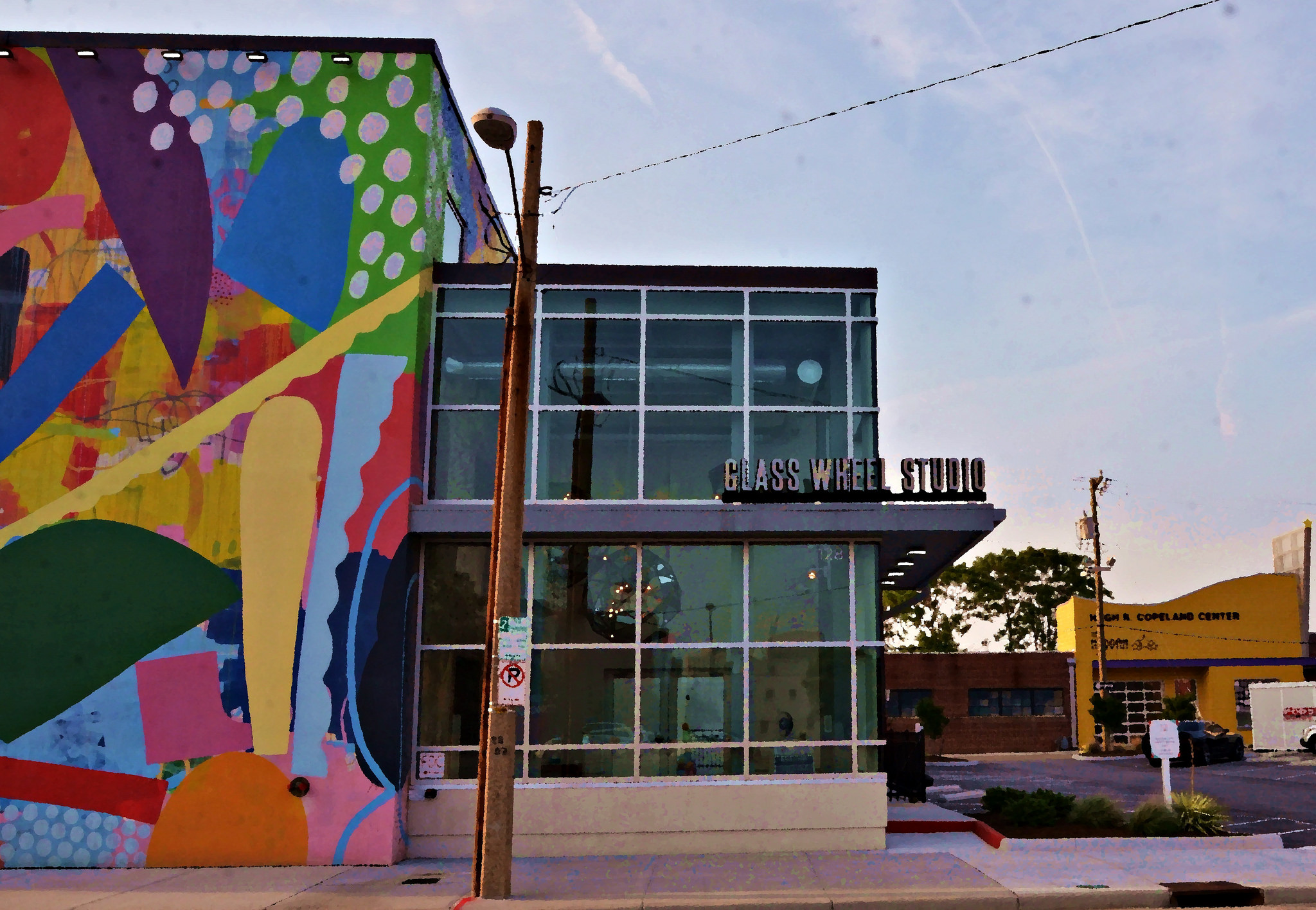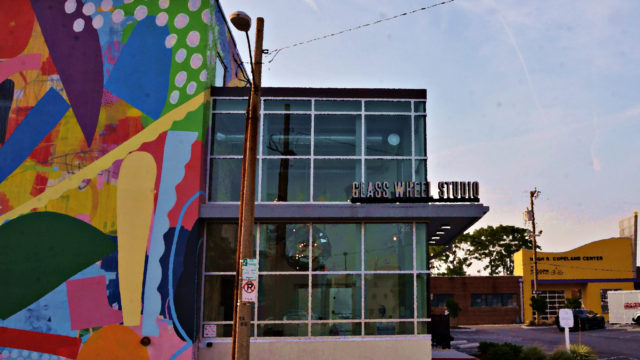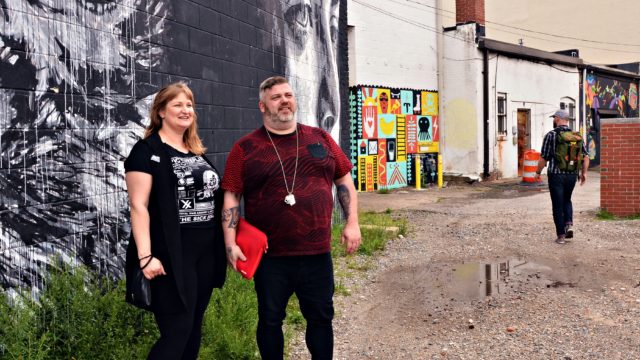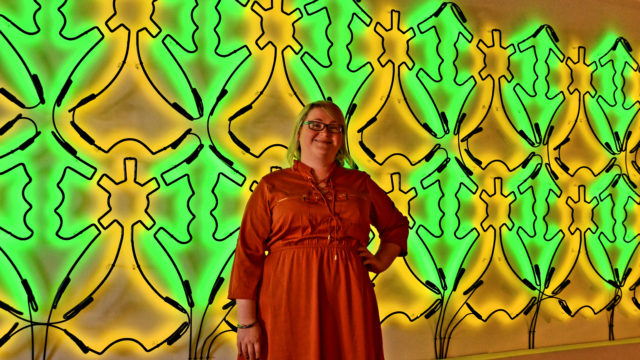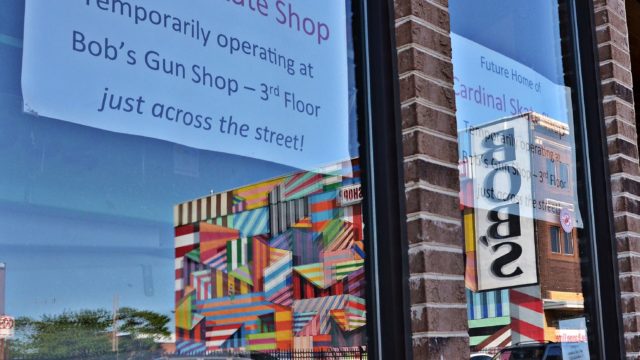Words & Photos by Jim Morrison
It’s 7 p.m. on an April Saturday in NEON, the New Energy of Norfolk arts district, and the lights may be on, but few people are home.
Six skateboarders practice their wheeled acrobatics at The Plot, the park along Granby Street, the district’s main artery. A handful of others are taking pictures during the magic hour in front of the murals that turn buildings, some renovated at a cost of millions and some showing their advanced age and neglect, into one of the finest street art displays in the state. There’s a show scheduled at the Push Comedy Theater, but it doesn’t start until later.
Alchemy NFK, once the communal heart of the district with space for artists and others, has been closed for two years. Pasted on the dilapidated building it called home is a notice that a 220 capacity, live venue called Unplugged has a Planning Commission hearing this month. That seems like a distant dream given the building’s condition.
The Parlor, once a dim, gritty home to music, is long closed after a conflict with neighbors over noise. Work/Release, the ambitious event and exhibit space and part-time restaurant, is down for renovations transforming it into a Norfolk version of Commune, the Virginia Beach restaurant.
On other nights over the past two years, though, NEON has pulsed with a cool heat, especially when Work/Release hosted events like the “Under the Gun” opening and shows with D.R.A.M., Kishi Bashi and Of Montreal.
In a few weeks, the district will have a sort of international debut when the Glass Arts Society brings its annual conference in Norfolk from June 1-3. About 1,200 people are expected to attend. The society’s block of rooms at the Marriott Waterside has sold out, according to Pam Koss, the executive director of the Glass Art Society. Cities hosting past conferences have estimated its economic impact at more than $1.5 million.
It’s a coup for the city. Previous conferences have been held in Seattle, San Jose, Chicago and Portland. The society’s choice is a reflection of the success of the Chrysler’s Glass Studio, the museum’s internationally-renowned glass collection, the enthusiasm of collectors in the area and the allure of the NEON district.
On her first visit to consider Norfolk as a host city, Koss says she saw little jewels in the NEON District spread apart. During a second visit last year, she felt like the blocks between the Glass Studio and the district had matured. “There’s a cohesiveness, a path where people can walk and see a lot of things they won’t see anywhere else,” she says.
Koss lived in the area during the early 1990s when her Navy pilot husband transferred here. “It is a completely different city from what I remember,” she says. “Now, it’s got this great edge to it.”
A home for Edge is one of the things a group of grassroots enthusiasts wanted to create when they began mapping ideas for an arts district years ago. The first public mention was in a column in The Virginian-Pilot in January 2013. Dozens of stories followed in the paper as well as in AltDaily. In the spring of 2013, City Council formally designated as an arts district the area roughly bounded by Chrysler Hall on the south, the Chrysler Museum on the west, the Harrison Opera House on the north and St. Paul’s Boulevard on the east.
NEON is managed by the Downtown Norfolk Council, a nonprofit funded largely with public money — $1.8 million of its $2.2 million in revenue in 2015 came from government grants and contributions, according to IRS records.
The district is a toddler, a work in progress. Businesses have come and gone. More are in the planning stages. There are anchors in place, the Glass Wheel Studio, Work/Release/Commune, the Hurrah Players building and theater and the Push Comedy Theater. There are a handful of new businesses, notably Zeke’s Beans and Bowls that gets regular foot traffic. Near the Chrysler Museum, there’s also Nouvelle, one of the best restaurants in town. The d’Art Center found a new home on Duke Street in the district. Cardinal Skate Shop’s move to NEON has been long delayed and there’s no proposed opening date, but Bearded Bird Brewing, another delayed project, opens in mid-May.
There are major infrastructure and flooding issues in the district. Work on the Olney Road sewer line and the degraded infrastructure means at least one venue in the district calls in a city sewer truck to deal with an overtaxed system during events.
In some ways, NEON is where Granby Street downtown was three decades ago, before the city invested hundreds of millions of dollars in improvements and incentives.
The district is many stories, some conflicting. It’s the story of what a small group of determined and organized creatives can do to create a home in a neglected neighborhood. It’s the story of how an image – an idea — sometimes promises more than the reality. It’s a story about how transforming blight is complicated and messy. It’s the inevitable story of people cashing in. And it’s the story of a city has been happy to market a fledgling arts district, especially to Millennials, but has been unwilling to offer incentives or major investment.
Four years ago, the Better Block project ignited interest in what became NEON. Here is a look at what has happened since. This is not comprehensive. Some old and new business owners and property owners did not reply to emails and phone calls seeking interviews. There is a kaleidoscope of perspectives. Here are a few.
The Visionaries
Jesse Scaccia and Hannah Serrano were the bold-faced champions for an arts district. They took an idea circulating among friends and wrote a white paper, circulating it to the city’s decision-makers. During that time, they were the publishers, editors and writers at AltDaily. Serrano has moved on to become the marketing director for O’Connor Brewing Co. Scaccia is a columnist for the Norfolk Compass and still runs AltDaily, the alternative news site now owned by the publishers of the mainstream daily newspaper. How does the district compare to their vision from years ago?
“To me some of the things I envisioned have come to fruition, but they’re just at the start,’ Serrano says, noting the combination of new business owners as well as buy-in from people like Brother and Meredith Rutter, who purchased and renovated the building housing Work/Release, creating a nonprofit with an artist residency.
Scaccia points to both the artistic success and the redevelopment success. The district is about all kinds of art, he says, from the art of brewing to the art of glass to the art of hair. He says NEON showcases the highest concentration of public art anywhere in Virginia other than Richmond.
“That’s what we were going for more than anything — making this a place where creative people can feel at home, too, along with the people who feel at home at Olive Gardens and the rest of the strip malls that is most of Hampton Roads,” he adds. “I think we’ve created a unique place where weirdos can feel at home more than anywhere else. And I’m a weirdo so it’s not derogatory.”
On the redevelopment side, he notes that people were afraid five years ago to walk through the area. Now, there are successful businesses with more coming. “It might not be that every storefront is full, but compared to what it was — I think there might be eight new businesses. There’s no way Zeke’s would be here. There’s no way Glass Wheel would be here. There’s no way Bearded Bird would be here. There’s no way Commune and Brother Rutter would have bought into this neighborhood. There’s no way the Hurrah Players would be here.”
There have been complaints that property owners have raised rents beyond what the market can bear. Scaccia has a different perspective. “I don’t think this market is going so bananas,” he says. “Let’s not act like this has become Chelsea (the Manhattan neighborhood that has transformed into a high-rent arts destination over two decades). This is Norfolk.”
“It’s a capitalist reality that the people with money are in control. I think we need a certain level of maturity as artists and creatives to play the ball where it’s laid,” he adds, noting the Rutters and others with deep pockets are working to make the district successful because it’s mutually beneficial.
“I don’t think there’s a place in America where there are bags of money on the corner that say artist on them. There is no magic arts district where artists can live for $100 and get unlimited arts supplies. I think people have a limited context sometimes of this aspirational arts district that is kind of a dreamland that doesn’t exist anywhere versus the grind of making it work. It can work. It just takes a lot of humility.”
Both agree the city has not invested in anything other than the public art. “The city didn’t do shit,” Scaccia says. “It got out of the way. It’s really been the people of Norfolk from the artists to the developer-level class that’s made it happen.”
What has happened, they say, is more than development. It’s a shift in the city’s image.
“I think this has changed how a lot of people see Norfolk,” Scaccia says. “They don’t have to go to Richmond or New York. It’s a statement that dreams can happen here. You can start your business. You can start your career. It’s been a real identity shifter for a generation and generations to come that Norfolk is not just an industrial Navy town, but it’s also a place where creativity can thrive and is welcome.”
“It comes down to jobs,” Serrano adds. “The more creative jobs there are, the more teenagers are going to want to stay here. Jobs and affordable cost of living and affordable housing.”
The Early Adopters
Charles Rasputin and Careyann Weinberg not only were major players in the birth of the arts district, they shepherded it and their fellow creators through its birth and infancy.
Alchemy NFK, their rambling cooperative space on Granby, opened in early 2013. It was home to skaters and bands and artists. It was also a sort of incubator for some of the big events and plans in the early days. The ideal of an arts collaborative didn’t last, though, and when their lease expired, they moved on to guide Work/Release under the patronage of the Rutters.
Rasputin came to the project as a freelance designer and events creator who grew up in Portsmouth and Virginia Beach and found a home in the arts — especially street art — after some dark days. Weinberg left a job at Grow to work in the arts district.
Now, they’ve moved on from Work/Release as the space becomes Commune, a restaurant. But they remain involved in the arts district. “There is a beautiful synergy that can take place between street smart art cred and academic art cred,” Rasputin says one morning sitting on the bleachers in The Plot. “When the NEON hits that synergy — and it has in so many places and it continues fully cranking — it’s inspiring people. It’s engaging them. Art and music and fashion are our spiritual problem solvers. Nothing brings folks together like human creativity.”
They have concerns about some of the property owners pursuing higher rents instead of tenants appropriate to an arts district. “When folks are more focused on what their neighbors can bring to their business idea rather than what their business idea can bring to the neighborhood,” Rasputin says, “it’s a red flag.”
Like others, they don’t see enough opportunities for working artists. “In order for this to continue as an arts district, there has to be places to support artists,” Weinberg says. “There has to be cheap rent or co-working space.”
Rasputin says Norfolk’s lack of incentives and Byzantine special exception ordinance, three months of jumping through hoops, are barriers other cities, like Virginia Beach, have not erected.
Norfolk, for instance, approved a blanket special exception for the new Waterside development that means individual restaurants and bars don’t have to jump through those hoops. In the NEON district, they still do. “That sort of barrier to entry is what will disenfranchise all the people who care about this neighborhood,” he adds. “They’ll get the hell out of here, go to another city or get tired of dealing with the same shit over and over.”
He also notes that the idea of using arts for marketing has been appropriated for public/private investments like The Main further south on Granby Street. The city sees a return on tax revenue, but Rasputin suggests looking at a different sort of return.
“If you invest in a community like this where young people of all walks of life — LGBT, African-American, white — live together, dance together, make art together,” he says, “you cannot put a dollar value on that.”
The Brain Who Stayed
Cheryl White was one of those friends who brainstormed about creating a place for artists in Norfolk. She was working at The Chrysler Museum then and envisioned — as others did — the boarded-up buildings in the district as blank canvases. The first project was a mural on the old Zedd’s building. Then came Art Everywhere downtown in 2010 followed by Better Block three years later.
“The goal was always to bring people here,” she says in her small office at Glass Wheel Studio. “This part of town had really great bones. We put some spotlight on it and we did it through art.”
Glass Wheel came about when Douglas Perry, a patron of the Chrysler’s Glass Studio asked Charlotte Potter, the studio’s founder and manager, if she needed anything. She mentioned that the arts district needed artists — and studios for them. A month later, he called to say he’d purchased a building that became the Glass Wheel Studio, an 8,500 square foot space with 13 affordable studios and two rotating galleries. Then he hired White to run the studio. She declines to give a number for the acquisition and renovation of the building — it was gutted — other than to say it was a multimillion-dollar project.
That’s one thing common to most of the successful destinations in NEON. They benefited from deep-pocket patrons. Work/Release had the Rutters. The Hurrah Players had a number of patrons, including the Perrys, and the Push Comedy Theater tapped an online funding campaign and the deep pockets of a retired Norfolk Southern executive and his wife.
In the less than two years it has been open, Glass Wheel has offered 14 exhibits. “We want to be a venue where you can see glass artists who maybe aren’t on the radar of every glass gallery,” White says.
She laments the lack of foot traffic in the area. Oh, the journalists pointed her way by Visit Norfolk, the travel marketing agency, stop by and shoot pictures of her Instagrammable building. NEON is highlighted on Visit Norfolk’s home page. But she wants there to be more to see and do. “The arts district will go through its ups and downs,” she adds. “We’re so very young. We’re really vulnerable. Some more buy-in would be lovely.”
She hopes that improves when Bearded Bird, Commune and the Cardinal Skate Shop come on board. “The public art in the NEON, our murals, it’s damn good,” she says. There are a few spots “to get people engaged for a while, but then it’s where I go? It would be great to have some cute, little retail shops, other things down here.”
It would be great, too, to have affordable places for artists to live in the arts district. White lives in Park Place. “I cannot afford to live in this district,” she says. “I can’t afford to live within four blocks of this district. It would be really lovely to see some kind of affordable housing come on line.”
She notes that NEON is not the only game in the region, not the only arts district. All of the others offer incentives that Norfolk does not. There’s nothing for the emerging business with a small budget. The buildings are old and neglected. There are flooding issues. Glass Wheel has six-foot floodgates on every door. That takes money, a lot of money. “The city needs to offer legitimate tax incentives that will be geared to property owners, existing or new businesses that will be renting and also real incentives that could play out at the individual level to somebody supporting the arts in an active way as well as the art makers,” she adds.
The major drivers of the arts district are many of the same volunteers who helped start it. There needs to be a transition. “The work of making the neighborhood work is still being done very much on a volunteer basis,” White adds. “You can’t expect volunteers to be able to have the time to do that kind of planning.”
White still holds to the ideal of the arts district and that ideal has a hold on her. She’s still in Norfolk, after all. She notes ruefully that all those stories about brain drain seemed to stop after the arts district came into focus. “I am enthusiastic,” she says. “If you would have told me seven years ago I would be able to do this in my hometown, I would have said you were crazy. This is amazing. ”
The Advocate
Rachel McCall joined the Downtown Norfolk Council three years ago as the special projects manager in charge of the NEON district. “We basically do a lot of matchmaking and business concierge services down there,” she says. “Basically, what we do downtown.”
Matching tenants with owners takes time. “We do have some roadblocks to development in the arts district,” she says. “The vacant spaces are vacant because they need a lot of work. Honestly, they’re a little pricey for what they are. There are flooding issues. There are very old properties that have not been improved in the last 40 years. We have some work to do.”
Asked about the early grassroots efforts merging with the patrons like the Rutters and Perrys, she has a different perspective. “The grassroots efforts were almost too successful,” she says. “All of a sudden property owners raised their rents. You did have significant investment by some major properties, but some of the smaller spaces have not been improved. Yet, the rents are too high for what they are. A lot of that grassroots does not have a place to go.”
“I do hear a lot around town that young artists feel like they can’t afford the rent in the arts district,” she adds. “I hate to hear that, but it’s true.”
She says interest in the district continues to grow. But is there enough there there? Like others, she worries the marketing overstates the reality. “Now, we need to provide things to do — lunch, shopping at a gallery, those kinds of daytime activities. My goal is to have it become a 24-hour neighborhood.”
The DNC would like to see basic improvements in the sidewalks, the lighting (arch lighting like on Granby south of Brambleton) and the landscaping. “It’s not that friendly to walk,” she notes. In 20 years, she says, the NEON district might look like Granby Street downtown.
“It takes a long time to do these things,” she adds. “We’re committed.”
The New Kid in Town
Jason Hawkes decided to move his business, Cardinal Skate Shop, from a Virginia Beach strip mall to the NEON district romanced by the idea he could be more than just another retail outlet. He wanted to represent the culture in a place he was proud of.
“I think this has so much potential,” he says. “I think when I bring in what I do, people will want to be part of the energy. People are going to want to see what we have going on.”
He considered other spots, but thought the NEON district would be most welcoming to his customers. He plans to open a few doors down from Bearded Bird and eventually build the only indoor skate bowl in the area in his store. “What I’m trying to do, I don’t think anybody is doing,” he says.
Renovations to his building have taken longer than expected so he’s open temporarily on the third floor of Bob’s Gun Shop, his landlord.
Old Kids on the Block
The Hurrah Players have been a local staple since 1984. So when they needed a better space for their scene shop, the NEON district made sense. Their new building, where they will house sets, teach set design, hold some classes and operate a black box theater opens this month. The acquisition and renovation of the building, originally built in 1907 to serve as a horse and cattle stable, cost about $2 million.
“By having a building in the arts district, we are able to increase our outreach programs, do more camps and have more classes,” says Hugh Copeland, the longtime artistic director. The theater, he notes, will allow them the freedom to do experimental plays without worrying about the ticket sales needed to fill a larger, rented venue.
“It’s a new vibe for us,” he says. “We think being there is a necessary part of our growth to be involved in the community and have outreach with other arts organizations.”
The City: North of Brambleton, West of Monticello
What is the worth of culture to a city, particularly youth culture? It depends upon the neighborhood.
South of Brambleton Avenue, of course, the city has invested heavily. Its contributions to recently-opened Hilton hotel, The Main, total nearly $103 million, according to The Virginian-Pilot. That’s more than 60 percent of the project’s cost.
In the arts, the hotel sees a marketing opportunity. The Main positions itself as “a beacon of arts and culture” and boasts an art collection it says is worth more than $1 million.
Meanwhile, north of Brambleton in the NEON district, there are no incentives or city contributions.
A proposal for modest support years ago got nowhere. In September 2013, Norfolk City Council heard a presentation from an assistant city manager about incentives for the arts district in addition to Enterprise Zone offerings (much of the district is in a zone).
A copy of the presentation shows the incentives included waiving permit fees and providing relief for business licenses and taxes. In one example, a web design agency that spent $75,000 renovating an existing storefront with revenues of $500,000 annually would save more than $30,000 over three years. An eatery spending $15,000 to rehab existing space and grossing $300,000 annually, would save more than $10,000.
According to an Inside Business story, Council member Paul Riddick asked then City Manager Marcus Jones when the city would focus on other areas of Norfolk, calling the west side of Monticello Avenue white Norfolk and the east side black Norfolk.
“You’re always jump-starting things on the other side of Monticello,” he said. “We’re dying over here.”
City Council did not adopt the recommendations.
According to city spokesman Lori Crouch, council is now awaiting recommendations from the NEON District Committee about incentives.
Just down the expressway, one of the first things Virginia Beach Council did after creating the VIBE arts district was to enact incentives. The plan rebates the business tax for 10 years, reimburses permit, inspection, planning, zoning and development services and allows for live-work units in the district. Williamsburg offers a similar program that adds a rebate of sales tax starting at 100 percent for the first year and dropping to 20 percent by the fifth year.
In 2012, Richmond created an arts district with incentives and a city marketing fund. The incentives include fee waivers and reductions, marketing help for individual businesses, money for affordable housing in the district and an interest rate reduction as high as 2 percent from loans made by the city through its revolving loan fund.
A report noted that cities as diverse as Pawtucket, Minneapolis and Portland, Maine, found investing in arts districts yielded a return both in dollars and in cultural appeal.
“The proposed incentives carry costs for the City,” the Richmond ordinance said, “however, these costs are expected to be greatly offset by the estimated increased tax revenue.”

